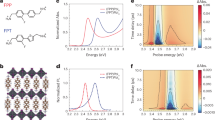Abstract
The nonradiative heterofusion of a host exciton with a guest molecule electronic excitation resulting in a higher electronic neutral single excited state is examined theoretically in the doped organic molecular crystals. The heterofusion process is treated as a nonradiative spontaneous multi-lattice phonon transition of the crystal from the electronic double excited initial state to the electronic single excited final state under the action of the interaction between the host molecules and the guest molecule. Two heterofusion channels are considered: the first one resulting in a higher electronic excited state of the guest molecule and the second one resulting in a higher host exciton state. The corresponding rate constants are calculated and discussed within the framework of the first order time dependent perturbation theory.
Similar content being viewed by others
References
Gaevskij A. S., Fajdyš A. N., Dokl AN SSSR172 (1967), 809.
Prijnaček V. R., Fajdyš A. N., Opt. i spektr.27 (1969), 431.
Prijnaček V. R., Fajdyš A. N., Izv. AN SSSR, Ser. fiz.34 (1970), 583.
Groff R. P., Merrifield R. E., Avakian P., Tomkiewicz Y., Phys. Rev. Letters25 (1970), 105.
Swenberg C. E., Geacintov N. E., Organic molecular photophysics, (Wiley, New York 1973).
Kalinowski J., Godlewski J., Chem. Phys. Letters25 (1974), 499.
Dexter D. L., Forster T., Knox R. S., Phys. status solidi34 (1969), K 159.
Förster T., Ann. Physik2 (1948). 55.
Dexter D. L., J. Chem. Phys.21 (1953), 836;Dexter D. L.,Schulman J. H., J. Chem. Phys.22 (1954), 1063.
Robinson G. W., Frosch R. P., J. Chem. Phys.37 (1962), 1962; J. Chem. Phys.38 (1963), 1187.
Markham J. J., Rev. Mod. Phys.31 (1959), 956.
Kubo R., Toyozawa Y., Progr. Theor. Phys.13 (1955), 160.
Condon E. U., Shortley G. H., The Theory of Atomic Spectra (Cambridge University Press, Cambridge, England 1953), 76.
Beuhler R., Hirschfelder J., Phys. Rev.83 (1951), 628.
Rice S. A., Yortner J., Comments on the theory of the exciton states of molecular crystals in Physics and Chemistry of the Organic Solid State vol. III (1967), 199. (J. Wiley & Sons, New York, London, Sydney).
Craig D. P., Walmsley S. H., Excitons in Molecular Crystals, W. A. Benjamin, Inc., New York 1968.
Author information
Authors and Affiliations
Rights and permissions
About this article
Cite this article
Trlifaj, M. Nonradiative heterofusion of excitons in doped organic molecular crystals. Czech J Phys 25, 1297–1307 (1975). https://doi.org/10.1007/BF01587353
Received:
Issue Date:
DOI: https://doi.org/10.1007/BF01587353




